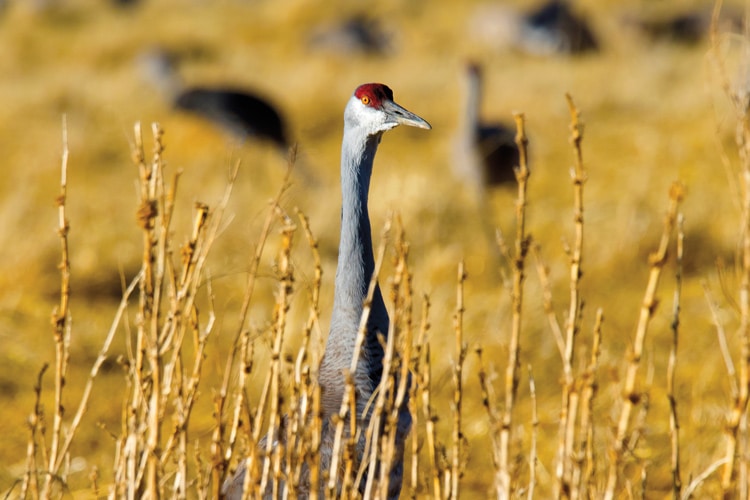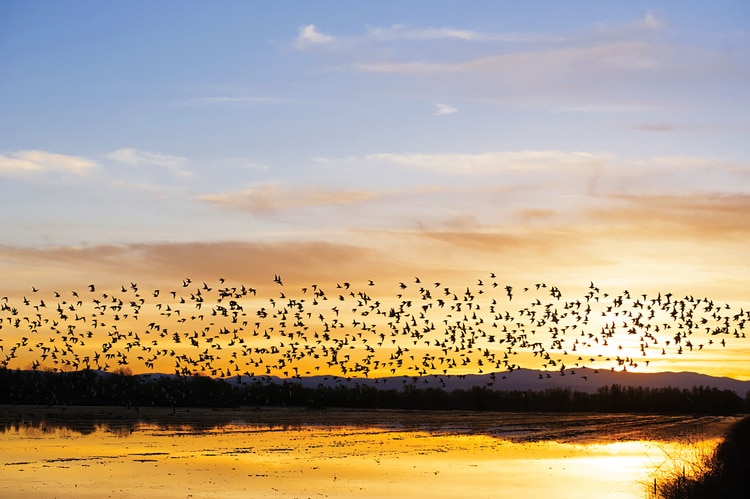Every August, Nancy and John Merrill flood a hay field on their ranch so that flocks of Rocky Mountain Greater Sandhill cranes can eat and rest during their staging season—a time when cranes make their cinematic stopover in northwest Colorado. One of the world’s largest migratory birds, the four-foot-tall omnivores love wetlands filled with insects and bugs, but they also love small grain waste.
The Merrills are part of Crops for Cranes, a nonprofit created by Colorado Crane Conservation Coalition (CCCC) to pay private landowners to plant wheat for migrating birds to eat before making their remarkable flight south for the winter.
A self-proclaimed craniac and full-time volunteer director of CCCC, Nancy was determined to keep cranes coming to the Yampa Valley. But, when the market value for grain crops started going down, so did the number of cranes coming to the area. “More and more farmers in the Yampa Valley were converting from growing wheat and oat to alfalfa and hay, which are much more profitable.”
The production of wheat and oat crops had dropped from 85,000 acres in the 1940s to only 10,000 today. How would these cranes get enough food to stay healthy for their 500-mile flight from Yampa to San Luis Valley (CO) for several weeks, and then, to take off again to Mexico and Arizona?

Crops for Cranes is working! In one morning alone, Nancy counted 203 cranes. Since beginning in 2015, as many as 1,200 cranes settle in the Valley each summer. It’s a win-win for wildlife and farmers, who are paid full market value for growing grain (except the Merrills who donate their field). Farmers cut the wheat, and cranes fatten up on the waste wheat that is left behind.
And, Nancy admits, it’s not just for the economy. She wants landowners to enjoy watching nature’s dancers fly up and show off their six-foot wing span, and hear their “annoying, unavoidable, loud” rattle song.
“The farmers working with us aren’t doing it for economic reasons alone. They’re doing it because they like cranes and wildlife.”
The loss of rest and re-fueling stops for migrators isn’t unique to the Yampa Valley, unfortunately. Even though cranes and other migratory birds have flown throughout North America for hundreds of years, they’re losing their stopover sites to urban and agricultural sprawl—everywhere.
Even worse, birds have been forgotten, believes Mark Reynolds, PhD, lead scientist for The Nature Conservancy California Chapter’s migratory bird program.
“All of us who work in conservation and wildlife management have realized that we’ve gotten really good at protecting areas, but a missing element has been protecting areas for birds.”
[Migratory birds’] use of land is the equivalent of how humans own a vacation home and vacation there for a few weeks a year.”
Mark Reynolds, PhD
Perhaps, because migratory birds use land much like humans. “Their use of land is the equivalent of how humans own a vacation home and vacation there for a few weeks a year.”
His analogy sparked Reynolds to come up with BirdReturns, an Airbnb concept to expand stopover sites throughout the Central Valley in California. If such a rental market sharing approach was successful for condos, surely it could work for conservation—and benefit both migrating shorebirds and farmers.
“Farmers already flood their fields to grow rice, and shallow water is perfect habitat for migrating shorebirds,” says Reynolds, who recruited California’s Point Blue Conservation Science nonprofit and Cornell Lab of Ornithology’s eBird to research when and where migratory birds are in the Central Valley, and to find locations that lack the right type of food, shelter and water. eBird is an easy mobile app for bird lovers to enter sightings online, adding yet another way for scientists to see a migrator’s movements, uncover trends, stopover use, locations, etc. The worldwide database logs two to three million bird watches per month!
Reynolds’ in-depth conversations with farmers proved that they could easily flood their fields for four, six or eight weeks, depending on their water supplies and farming schedule. Since 2013, BirdReturns has provided an online “reverse auction” for farmers to submit competitive bids. In the first season alone, more than 220,000 migrators, averaging about 100 birds per acre, visited participating farm fields.
“The counts have been extraordinary!” says Reynolds. “We documented 5,000 Dunlin (known for its long, drooping bill) on one farm field. Farmers are bringing wetlands back, even if only for a couple weeks a year.”
BirdReturns now contracts with over 100 rice farmers that provide 55,113 acres in the Sacramento Valley for migrating shorebirds, geese and other waterfowl to roost and feed on worms, crustaceans and other invertebrates.
A consummate bird cheerleader, Reynolds recently brought California Rice Commission on board. “This is an exciting way for humans to help this wildlife persist. Think about all that we need for birds and other wildlife, and just the sheer acreage of our landscape that is privately owned.”

Figuring Out the Mystery of Migration
The lives of migratory birds are mysterious. Even to ornithologists! Despite decades of research, it is extremely challenging to understand where different populations of birds are moving, says Jeff Buler, PhD, a radar ornithologist at University of Delaware, “since most species take off in the evening, fly through the first part of the night and land at sunrise.”
“Migration has always been a black box,” says Buler, whose seven-year study using weather radar let him observe daytime habitat for the first time. Buler used the very lowest beam of the national weather system’s radar to watch birds right when they leave the ground for their nighttime flight.
They learned why growing numbers of nighttime migrators, like warblers and sparrows, are not surviving. “Too many stopover sights have dwindled and increasing numbers of birds are disappearing and dying during migration.” When stopovers that they have used year after year are suddenly nonexistent, birds have to use extra energy to find another one.
It’s energy that they don’t have. Birds can lose as much as one-quarter to half of their body weight as they make remarkable journeys of six to 24, and up to three nonstop days for the Black Pole Warbler flying over the Atlantic.
How do birds find new places to stop? How do they manage to find their destination? Thankfully, one thing hasn’t changed, says Buler. “Birds are born with a map sense. They have inherent navigational cues, and they build a map with their mind.”
Some birds use the sun and the stars to navigate. Some also use the sighting of landmarks, rivers and mountains. But, way too many are being completely misled by city lights, Buler’s study revealed.
“They see the glow from three miles away. For instance, birds migrating in the middle of the Adirondack Mountains can see the lights of New York City!” Then, they fly lower toward the beams and get trapped in the beams—becoming disoriented and eventually, landing from exhaustion.
Buler credits The Audubon Society’s Lights Out Program for digging deep to find out why birds are colliding into buildings. New York City Audubon’s studies date back to 1997, when they worked with a researcher and recruited volunteers to walk and record the location of every dead bird they sighted on a sidewalk.
We were finally able to identify exactly which buildings birds were flying into. . .”
Susan Elbin, PhD
“We were finally able to identify exactly which buildings birds were flying into,” explains Susan Elbin, PhD, director of conservation and science. “We learned how lights on change the behavior of a bird in flight.”
Lights and reflective glass are the culprit, causing 90-200,000 birds a year to collide into New York City buildings and fall to their death. From a bird’s eye view, a window looks like a tunnel or, they see their own reflection and try to attack it. Elbin is quick to clarify, “Birds aren’t flying into 85th story windows. They are colliding with windows mostly in the first four stories in both urban and rural areas.”
Turning off lights frees birds and cuts building utility expenses. To date, about 100 buildings have signed on with NYC Audubon to turn off lights twice a year and turn off decorative lights at night during migration.
Winning Over Both Birds and Humans
What’s good for birds is good for humans—and the economy! Whether you’re an ornithologist, farmer, conservationist, bird lover. . . everyone has creative ideas to make room for migrators, says Reynolds.
The Yampa Valley Crane Festival is a perfect example. Since 2012, the four-day festival draws nearly 2,500 bird lovers, scientists and tourists from across the globe. As festival co-founder, Nancy reached out to Crops for Cranes farmers to provide prime viewing spots and tours.
She has not only given cranes a place to gather and socialize; Nancy gathers CCCC farmers, festival volunteers, speakers and donors for dinner at the Merrill’s ranch. It’s been yet another piece of fulfilling her personal dream at Yampavian Ranch—that she named for the Yampa River running through it and to honor all the ranch avians.
“My dream for the ranch has always been both to attract and protect birds and to provide access to birders and researchers to learn more about the birds.”
For more information about The 8th Annual Yampa Valley Crane Festival,
August 29–September 1, 2019, visit https://ColoradoCranes.org/2019-festival.
Making Your Own Stopover Site
Here’s a guide to making your property bird-friendly:
Food:
- Leave a section of your yard or land un-mowed, so birds can feed on seed heads. Avoid large, open, pristine, groomed lawns.
- Don’t use pesticides!
- Let grasshoppers, flies, spiders, ants, gnats, roly-polys, worms, all insects live! Many migrators eat insects exclusively.
- Put bird feeders within 3–32 feet of windows, 9–32 feet of shrubs.
Plants and trees:
- Layer vegetation, such as canopy trees, understory trees and ground cover.
- Plant more shrubs! Birds hide in shrubs, taking shelter from predators and weather, plus, they feed on shrub berries.
- Native plants bring native insects! Use National Audubon Society’s Native Plants Database: https://www.Audubon.org/native-plants
Cats:
- Keep cats indoors, always! Fledglings are prey for feral cats to attack and kill.
Lights:
- Turn off all interior and exterior lights at night.
- Install motion-activated lights.
Windows:
- Put bird-friendly film or stickers on windows.
Water:
- Provide a water source for birds to wash feathers. Fluffed, clean feathers keep migrators warm.



